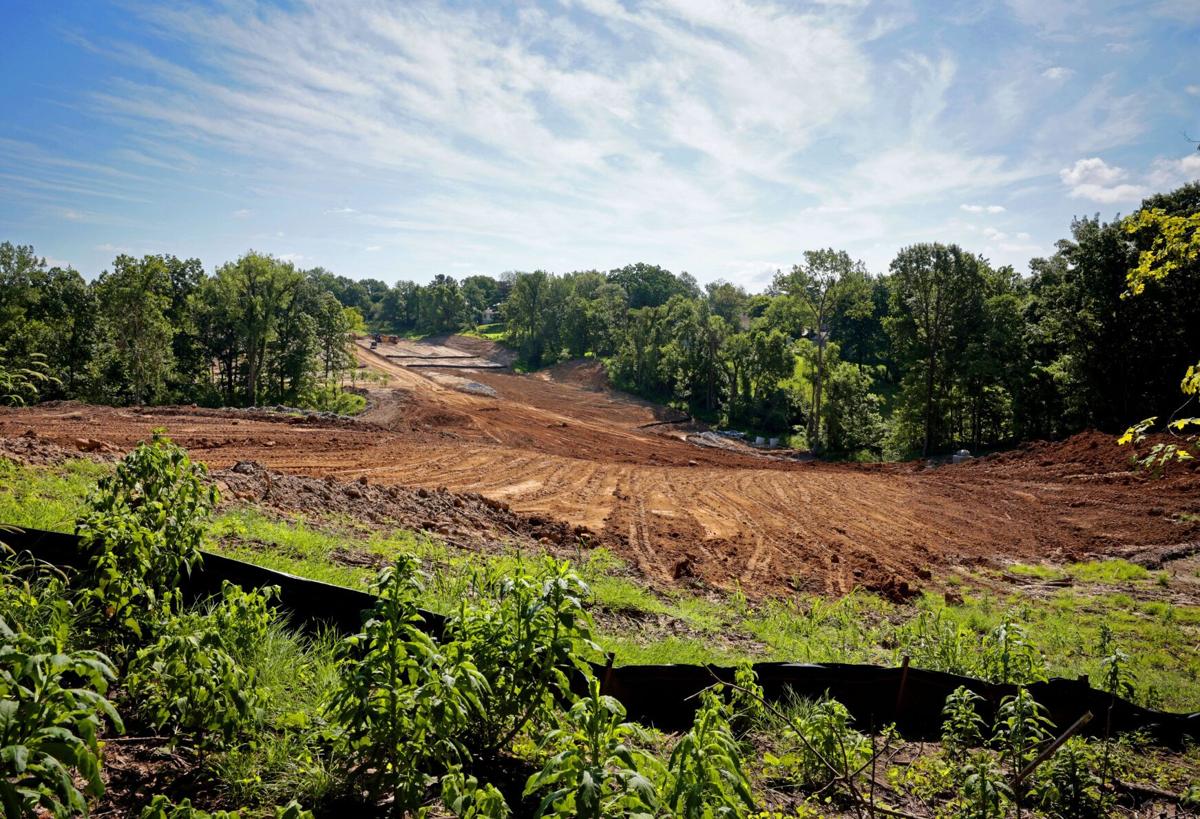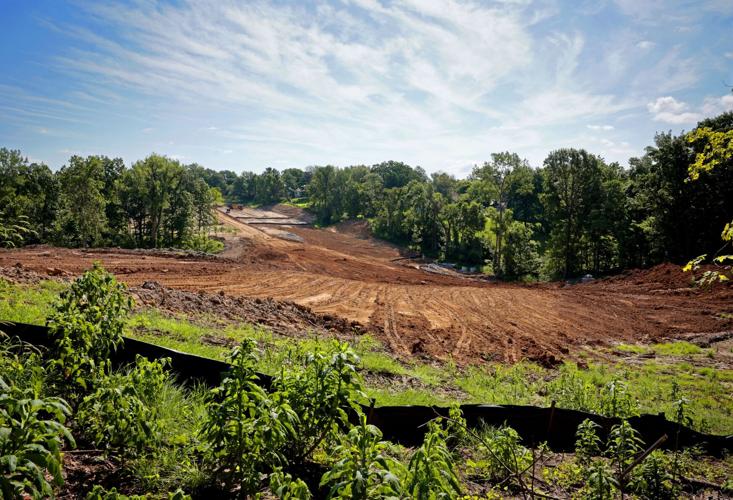MARYLAND HEIGHTS — A new subdivision nestled east of Creve Coeur Park has drawn the ire of neighbors and caught the wrong kind of attention from the state of Missouri before a single foundation has even been poured.
McBride Homes last year cleared 15 acres of hilly woodlands on Rule Avenue, off Dorsett Road, to make way for 39 homes that will start at $440,000 and up.
Neighbors, however, say the project has worsened flooding along Louiselle Creek, which cuts through the development site and runs alongside several Rule Avenue condominiums and single-family homes. They say their concerns largely have been ignored, and some fear they eventually could lose their homes.
Steph Kukuljan and other business reporters bring you insights into St. Louis-area real estate and development.
“Just because everything got built around our little house, our house has to suffer now?” said Luke Sanders, whose family has lived in a 1930s-era bungalow at the end of Rule for 13 years. “It can’t make it to 100 years old because everybody wants to build around here?”
People are also reading…
New stormwater infrastructure in recent years kicked off a building boom in the city of Maryland Heights. The city created an economic development department to help steer strategy as developers rushed to put up new office buildings, warehouses and other businesses. New housing subdivisions, such as McBride’s Louiselle Park development here, soon followed.
Critics say the city is prioritizing new money at the cost of its longtime residents, a point they say was underscored by the Missouri Department of Natural Resources when it cited McBride several times over the past year for a lack of erosion control, stormwater runoff and pollution at the Louiselle Park project.
McBride CEO Jake Eilermann said any new flooding cannot directly be attributed to his company, which he said followed all state and local rules and regulations before it began work.
“I understand their concerns, but they really shouldn’t have concerns,” Eilermann said. “That’s why there is zoning and plan approval, and we hire civil engineers. We’ll spend hundreds of thousands of dollars in engineering fees before we even start these projects.”
State violations
For many years, the land at 2212 Rule contained just one house. It was demolished in 2013, and a decade later, Eilermann said the landowner reached out to his company offering to sell.
The property already was zoned residential, making the approval process swift. The Maryland Heights City Council approved McBride’s project in March 2024, just a few months after the homebuilder submitted its plans. No public hearing was required.
Rule Avenue residents said the short time frame narrowed their chance to share their concerns with public officials. Regular council meetings allowed just two minutes per person.
“The community didn’t have a voice,” resident Christine Bales said.
Sanders, the homeowner, said he went before the City Council to warn the McBride development would worsen conditions for his home.
“I feel like it fell on deaf ears,” he said. “They’re going to build this thing regardless.”

Fifteen acres of woods were cleared off Rule Avenue in Maryland Heights for Louiselle Park, a McBride Homes development project, shown here on Tuesday, July 29, 2025. Neighbors believe the project has worsened flooding in the area.
One month before city officials approved the project, the Missouri Department of Natural Resources received an “environmental concern” from an undisclosed party. The state visited the site and saw a visible increase in the Louiselle Creek’s murkiness and sent a letter of warning informing the developer to make improvements.
The site was back in compliance by September. Then, in December of 2024, the state received a complaint that trees were torn down with no erosion control in place.
The DNR determined the homebuilder violated regulations and caused sediment to flow through Louiselle Creek. Scientists say sediment — silt and sand — settles to the bottom of a creek and can smother aquatic organisms and destroy or degrade habitats. Sediment also can become contaminated with toxic pollutants, threatening aquatic life or creating health hazards for people.
In April, after the state sent a notice of violation to the homebuilder, the DNR audited Maryland Heights’ stormwater program and observed a city worker’s inspection of the site. The agency found “missing, failing and insufficient (best management practices) and water quality violations at the site,” according to agency records. A water sample determined the housing development sent dirt and concrete particles down Louiselle Creek.
DNR notified the developer this summer that it was referring the site’s violations to its water protection program enforcement division where the builder could face penalties. The agency told the Post-Dispatch it would work with the developer on compliance and that there is no timeline for a decision.
Eilermann, the McBride CEO, acknowledged the DNR violations and said he believes the two organizations have found a solution. The land, he said, has been one of the trickiest properties his company has developed due to the terrain and soppy weather this past year.
“We’re doing everything we can to keep up with the weather and DNR compliance,” Eilermann said. “This isn’t our first time dealing with a tough site, but it definitely has its challenges when it’s raining inches at a time.”
He said his workers have finished earthen work at the site — what he says likely is causing the neighbors’ complaints about mud and dust — and he expects the first foundations to be poured in September and October. Sod and landscaping will follow and the area will fill in like a normal subdivision, he said.
The developer already has sold 23 of the 39 sites, he said.
‘Never dealt with that before’
Sanders and his wife, Paula, are lifelong Maryland Heights residents. When searching for their first home in 2012, the picturesque bungalow with a bridge over the Louiselle Creek situated next to the Quarry at Crystal Springs Golf Course and Creve Coeur Park “spoke for itself,” Luke Sanders said.
It was built in 1935 when few people lived this far west into St. Louis County. Only the occasional golf ball hitting the leaves of Sanders’ trees breaks up the chorus of the katydids.
“I go out there in the evenings with my girls and we go fishing,” he said. “We have 2 1/2 acres, and we love the yard. It’s like a little slice of privacy.”

Luke, right, and Paula Sanders, standing outside their home on Rule Avenue in Maryland Heights on Tuesday, July 29, 2025, believe the clearing of woods for a nearby McBride Homes development project has caused Louiselle Creek to flood excessively.
His front door is steps from the creek, but until recently, the water never crested above its banks. The federal government has designated the area a 500-year floodplain. That means the area has a .2%, or 1-in-500, chance of flooding in any given year.
A storm in June caused the creek water to rise ankle deep.
“It’s crazy what this turns into. Just a roar and rushing,” Sanders said.
Sanders has taken steps to protect his home: He bought flood insurance and added drain basins and rocks along the banks of the creek. The couple also pull tree limbs and other debris from the creek to prevent backups that could cause water to overflow into their yard.

Louiselle Creek breached its banks during a recent rainstorm this summer, where water flooded Luke and Paula Sanders’ front yard and garage.
Nash Haxel, the general partner of the nearby golf course, said the Louiselle Creek rarely left its banks until the past year. Three times this spring, he said, creek waters and mud have encroached even though the stream does not run directly through the property.
“It comes over the shore and comes to the fairways. We’ve never dealt with that before,” Haxel said. “Maybe when everything’s finished (it’ll stop). ... In the meantime, it’s causing havoc.”

The drone photo shows the aftermath of flooding from the Louiselle Creek at the Quarry at Crystal Springs Golf Club earlier this summer.
The city of Maryland Heights declined an interview but issued a statement noting that erosion control measures, such as silt fences and stormwater basins, are included in the approved plans.
This site is subject to oversight from several regulatory bodies beyond the city, according to the statement, including the DNR, the Army Corps of Engineers, the Metropolitan St. Louis Sewer District and St. Louis County Department of Health.
“While we understand some neighboring residents are disappointed to lose a wooded buffer behind their homes, the property was privately owned and appropriately zoned for residential use,” the city said.

The aftermath of a June 30, 2025 flood. Homeowner Luke Sanders said floodwaters were powerful enough to damage his garage door, as well as track in mud.

The aftermath of a June 30, 2025 flood. Homeowner Luke Sanders said floodwaters were powerful enough to damage his garage door, as well as track in mud.

The Louiselle Creek breached its banks, flooding the property of Luke Sanders.
Post-Dispatch photographers capture tens of thousands of images every year. See some of their best work that was either taken in June 2025 in this video. Edited by Jenna Jones.




























